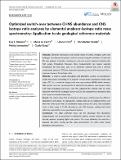Files in this item
Optimized switch-over between CHNS abundance and CNS isotope ratio analyses by elemental analyzer-isotope ratio mass spectrometry : application to six geological reference materials
Item metadata
| dc.contributor.author | Stueeken, Eva | |
| dc.contributor.author | de Castro, Maria | |
| dc.contributor.author | Krotz, Liliana | |
| dc.contributor.author | Brodie, Christopher | |
| dc.contributor.author | Iammarino, Mattia | |
| dc.contributor.author | Giazzi, Guido | |
| dc.date.accessioned | 2020-07-29T11:30:01Z | |
| dc.date.available | 2020-07-29T11:30:01Z | |
| dc.date.issued | 2020-09-30 | |
| dc.identifier | 267798225 | |
| dc.identifier | de26a53c-4bf4-409d-963b-6c8422c2d764 | |
| dc.identifier | 85089422079 | |
| dc.identifier | 000570965600010 | |
| dc.identifier.citation | Stueeken , E , de Castro , M , Krotz , L , Brodie , C , Iammarino , M & Giazzi , G 2020 , ' Optimized switch-over between CHNS abundance and CNS isotope ratio analyses by elemental analyzer-isotope ratio mass spectrometry : application to six geological reference materials ' , Rapid Communications in Mass Spectrometry , vol. 34 , no. 18 , e8821 . https://doi.org/10.1002/rcm.8821 | en |
| dc.identifier.issn | 0951-4198 | |
| dc.identifier.other | ORCID: /0000-0001-6861-2490/work/78205098 | |
| dc.identifier.uri | https://hdl.handle.net/10023/20357 | |
| dc.description | EES thanks Tommaso Di Rocco for technical assistance and acknowledges start-up funds from the School of Earth & Environmental Sciences, St Andrews. | en |
| dc.description.abstract | Rationale : Elemental abundances and isotopic ratios of carbon, nitrogen, sulfur and hydrogen have become important tools for reconstructing the evolution of Earth and life over geologic timescales, requiring accurate and precise analytical methods with high sample throughput. However, these measurements may require separate instruments for each task, such as an elemental analyzer (EA) with a thermal conductivity detector (TCD) for elemental abundances and an EA interfaced with a mass spectrometer for isotopic ratios. Methods : To improve sample throughput and laboratory up‐time, we developed a switch that allows converting an EA IsoLink™ system from a standalone mode using only a TCD to a mode for isotope ratio mass spectrometry (IRMS) within minutes. This permits accurate measurements of elemental abundances and isotopic ratios with high throughput and lower cost. We validated this method with six shale standards from the US Geological Survey (USGS) and compared our abundance data with those from another laboratory. Results : Our results show that (a) abundance data agree well between the different laboratories and setups; (b) reproducible isotopic data can be obtained before and after the switch‐over from EA standalone mode; and (c) the USGS rock standards cover a wide range in CHNS abundances and CNS isotopes, making them ideal reference materials for future geochemical studies. Conclusions : This ideal analytical setup has the advantage that abundance measurements can be performed to determine optimal sample amounts for later isotopic analyses, ensuring higher data quality. Our setup eliminates the need for a separate EA while freeing up the mass spectrometer for other tasks during abundance measurements. | |
| dc.format.extent | 11 | |
| dc.format.extent | 2220738 | |
| dc.language.iso | eng | |
| dc.relation.ispartof | Rapid Communications in Mass Spectrometry | en |
| dc.subject | GE Environmental Sciences | en |
| dc.subject | QE Geology | en |
| dc.subject | DAS | en |
| dc.subject.lcc | GE | en |
| dc.subject.lcc | QE | en |
| dc.title | Optimized switch-over between CHNS abundance and CNS isotope ratio analyses by elemental analyzer-isotope ratio mass spectrometry : application to six geological reference materials | en |
| dc.type | Journal article | en |
| dc.contributor.institution | University of St Andrews. School of Earth & Environmental Sciences | en |
| dc.contributor.institution | University of St Andrews. St Andrews Centre for Exoplanet Science | en |
| dc.identifier.doi | https://doi.org/10.1002/rcm.8821 | |
| dc.description.status | Peer reviewed | en |
This item appears in the following Collection(s)
Items in the St Andrews Research Repository are protected by copyright, with all rights reserved, unless otherwise indicated.

